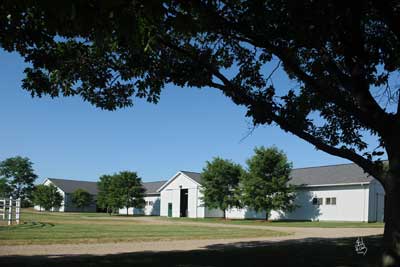Farm visit series: MSU Horse Teaching and Research Center
Learn more about the activities happening at the MSU Horse Teaching and Research Center.
This is a new series by Michigan State University Extension focusing on the beautiful and active animal farms at Michigan State University (MSU)! This article is about the MSU Horse Teaching & Research Center (HTRC). Check out this great video here.
Did you know that MSU boasts one of the oldest continuous Arabian horse breeding programs in the United States? The primary mission of the HTRC is to educate the next generation of Michigan horse  persons and solve industry problems through applied scientific research. It has always been the philosophy at MSU to maintain the highest quality livestock on our farms for those purposes. MSU has been breeding purebred Arabians since the 1940's, and continues to use them in the teaching and research programs conducted at the MSU HTRC.
persons and solve industry problems through applied scientific research. It has always been the philosophy at MSU to maintain the highest quality livestock on our farms for those purposes. MSU has been breeding purebred Arabians since the 1940's, and continues to use them in the teaching and research programs conducted at the MSU HTRC.
I recently sat down with Paula Hitzler, manager of MSU HTRC, to discuss both her role and the facility’s role in the MSU Horse Program.
Taylor: Can the public visit the farm?
Paula: The public is welcome to visit daily, Monday-Friday from 8:00 a.m. - 4:30 p.m. Believe it or not, the MSU HTRC will have about 60,000 visitors at the farm annually! Foaling season, which is from late April until late June, is generally the most popular time of year to visit, as everyone loves to see the new foals. When the weather is nice, many families will even enjoy a picnic at the farm.
Taylor: What classes or research are happening at the farm?
Paula: Typically the farm will have at least five classes per semester. The classes will range from horsemanship, starting young horses under saddle, a handling class for weanlings and yearlings, reproduction labs, and introduction to horse management. The MSU HTRC will usually have one to two research projects per semester. Most of the research that has been done recently has been nutrition based, but we also do research in performance horse biomechanics and behavior.
Taylor: What is your favorite part of your job?
Paula: My favorite part of the job is working with students and sharing my knowledge with them. I also really love teaching students to train horses both under saddle and preparing them for the show ring.
Taylor: What is the most difficult part of your job?
Paula: Most difficult? Nothing is really difficult, but I don’t like the days when I have to go to meetings or do a lot of paper work and don’t get to have horse contact! (She says with a smile)
A big thank you to Paula for spending time away from her very busy schedule to give us a little more insight about the MSU HTRC. Interested in learning even more? Visit www.msuarabians.com.



 Print
Print Email
Email



